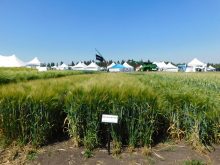At FarmTech last month, the membership of the Alberta Wheat Commission passed a resolution to explore the possibility of one governance structure with the Alberta Barley Commission.
Alberta Barley passed a similar resolution at its AGM in December.
The exploratory process shouldn’t be clouded by turf wars on the employee side of things since the two organizations actually share all of their staff, and have since January 2018. Sharing staff saved farmers $410,000 for fiscal year 2018-19 — money that can instead be spent on research, advocacy and extension to increase producer profitability.
Read Also

U.S. wheat growers worried about industry moving north
U.S. wheat producers are concerned that American wheat production may begin to migrate north of the border.
In November, I attended a regional meeting for the two organizations where Tom Steve, general manager for both, acknowledged the cost savings associated with amalgamating the governance structure won’t be as noticeable, since board function is more of a variable cost than a fixed overhead cost.
Our provincial commissions including wheat, barley, pulses and canola should — and do — work together and speak with one voice on the issues that the producers of these crops have in common, both to be more effective and to save money. I believe the sharing of staff between Alberta Wheat and Alberta Barley is a great example of this.
So is Team Alberta — the name given to the shared government lobby efforts of the two cereal commissions as well as Alberta Pulse and Alberta Canola. Staff and board members from all four organizations develop policy and response to government activities, and travel together to present these views in both Edmonton and Ottawa.
FarmTech, CanolaPalooza, grain-grading courses, and many other extension events are another example of the four commissions working together to increase producer knowledge and improve farming practices.
So as positive as I feel about the commissions working together, you might be surprised to read that I am not in favour of merging these commissions — I’m even a little surprised myself that I feel this way.
My concern mainly is with diversity of voice and representation on the boards. Right now there are 11 board members for Alberta Wheat and nine for Alberta Barley. That’s 20 minds and voices to contribute to improving the world for wheat and barley farmers in Alberta. A joint commission would knock that number down considerably.
If Alberta farmers went even further down the road and formed an all-crops commission — as is under serious consideration in Manitoba — we would go from 44 representatives on four commissions to much fewer.
I know it can be difficult for commodity boards to attract and retain elected representatives. However, I think reducing the number of leadership positions is the wrong approach.
Instead, we need to work to make the roles more appealing and perhaps less overwhelming to a more diverse swath of farmers. If we have fewer board seats, we will have fewer opportunities to draw new and under-represented voices to the forefront of farm policy.
I also believe that the more crops an organization represents the more removed farmers will become from making decisions on the agricultural issues of the day.
Directors on the four existing commissions can drill down into matters of trade, agronomy, legislation and research related to their respective crop type. If the same directors now need a working knowledge of multiple crop types, their knowledge will necessarily become higher level and they will become more dependent on staff expertise.
Now, I’m not proposing that commissions should have ‘working boards’ — I believe they should still function as a policy board with the staff doing the implementation.
But I believe policy is best set by those who have a deep knowledge of the issues. And I’m not disparaging the wealth of experience that commission staff bring to farm groups. We would be lost without them. However, decisions still need to be made by those with a vested interest in the outcomes — farmers. The bigger the portfolio, the more bureaucratic the organization will become by necessity.
Manitoba is proposing to deal with some of these challenges by having committees represent different crops. This might be a good solution for that province’s farmers, but I don’t think it’s practical in Alberta where the growing region stretches from High Level to the U.S. border.
It’s great to see the four Alberta crop commissions in a healthy place both financially and culturally.
They are working together for the good of Alberta farmers and I heartily endorse further exploration of ways they can collaborate to conserve resources and produce better results.
However, I don’t think we would be well served by reducing the number of commissions or board seats we currently have. We need to maintain all the opportunities we have for the grassroots voice of producers to be heard.
– Sarah Hoffmann is a grain farmer and manager of Alect Seeds near Three Hills.















